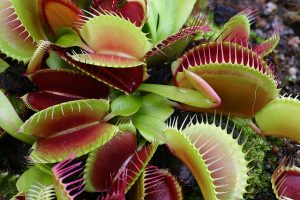Venus flytrap
Dionaea muscipula
Family:-Droseraceae
Description
The Venus flytrap is a most remarkable and very recognisable plant. Its leaves are modified in an extraordinary way in order to trap and feed on small insects.
The leaf blades terminate in distinctive bivalve traps whose edges are lined with teeth that interlock to enclose the victims. Delicate trigger hairs occur on the inside face of each blade, which if doubly disturbed by an insect causes’ the trap to close. Enzyme-rich fluids are secreted from the inside the leaves that slowly digest the trapped insect and are reabsorbed by the plant- leaving the protective outer husk to be discharged some days later.
Place of origin
The Venus flytrap is native to the wild areas of North and South Carolina in the USA.
Did you know?
Each flytrap can consume about 4 to 6 prey, after which the leaves wither to be succeeded by new growths. Although able to photosynthesis, the plants carnivorous behavior enables it to obtain vital nitrogenous nutrients that are otherwise in short supply in its natural habitat. There are reports that small frogs have been trapped and partly digested by the Venus fly-trap.

